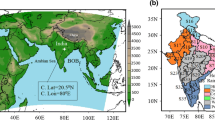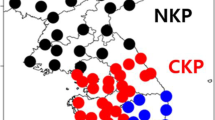Abstract
Future changes in East Asian summer monsoon precipitation climatology, frequency, and intensity are analyzed using historical climate simulations and future climate simulations under the RCP4.5 scenario using the World Climate Research Programme’s (WCRP) Coupled Model Intercomparison Project 5 (CMIP5) multi-model dataset. The model reproducibility is evaluated, and well performance in the present-day climate simulation can be obtained by most of the studied models. However, underestimation is obvious over the East Asian region for precipitation climatology and precipitation intensity, and overestimation is observed for precipitation frequency. The overestimation of precipitation frequency is mainly due to the large positive bias of the light precipitation (precipitation <10 mm/day) days, and the underestimation of precipitation intensity is mainly caused by the negative bias of the intense precipitation (precipitation >10 mm/day) intensity. For the future climate simulations, simple multi-model ensemble (MME) averages using all of the models show increases in precipitation and its intensity over almost all of East Asia, while the precipitation frequency is projected to decrease over eastern China and around Japan and increase in other regions. When the weighted MME is considered, no large difference can be observed compared with the simple MME. For the MME using the six best models that have good performance in simulating the present-day climate, the future climate changes over East Asia are very similar to those predicted using all of the models. Further analysis shows that the frequency and intensity of intense precipitation events are also projected to significantly increase over East Asia. Increases in precipitation frequency and intensity are the main contributors to increases in precipitation, and the contribution of frequency increases (contributed by 40.8 % in the near future and by 58.9 % by the end of the twenty-first century) is much larger than that of intensity increases (contributed by 29.9 % in the near future and by 30.1 % by the end of the twenty-first century). This finding also implies an increased risk of intense precipitation events over the East Asian region under global warming scenario. These results regarding future climate simulations show much greater reliability than those using CMIP3 simulations.















Similar content being viewed by others
References
Buhe C (2003) Simulation of the future change of East Asian monsoon climate using the IPCC SRES A2 and B2 scenarios. Chin Sci Bull 48:1024–1030
Chen HP (2013) Projected change in extreme rainfall events in China by the end of the 21st century using CMIP5 models. Chin Sci Bull. doi:10.1007/s11434-012-5612-2
Chen HP, Sun JQ (2009) How the “best” models project the future precipitation change in China. Adv Atmos Sci 26(4):773–782
Chen HP, Sun JQ, Chen XL (2012a) The projection and uncertainty analysis of summer precipitation in China and the variations of associated atmospheric circulation field. Clim Environ Res (in Chinese) 17(2):171–183
Chen HP, Sun JQ, Chen XL, Zhou W (2012b) CGCM projections of heavy rainfall events in China. Int J Climatol 32:441–450
Chen HP, Sun JQ, Chen XL (2013) Future changes of drought and flood events in China under global warming scenario. Atmos Oceanic Sci Lett 6(1):8–13
Dai A (2006) Precipitation characteristics in eighteen coupled climate models. J Clim 19:4605–4630
Frich P, Alexander LV, Della-Marta P, Gleason B, Haylock M, Klein Tank AMG, Peterson T (2002) Observed coherent changes in climatic extremes during the second half of the twentieth century. Clim Res 19:193–212
Gao XJ, Shi Y, Song R, Giorgi F, Wang Y, Zhang D (2008) Reduction of future monsoon precipitation over China: comparison between a high resolution RCM simulation and the driving GCM. Meteorol Atmos Phys 100:73–86
Gao XJ, Shi Y, Giorgi F (2011) A high resolution simulation of climate change over China. Sci China Earth Sci 54:462–472
Gao XJ, Shi Y, Zhang DF, Giorgi F (2012) Climate change in China in the 21st century as simulated by a high resolution regional climate model. Chin Sci Bull 57:1188–1195
Gillett NP, Zwiers FW, Weaver AJ, Hegerl GC, Allen MR, Stott PA (2002) Detecting anthropogenic influence with a multi-model ensemble. Geophys Res Lett 29(20):1970. doi:10.1029/2002GL015836
Gu H, Wang GL, Yu ZB, Mei R (2012) Assessing future climate changes and extreme indicators in east and south Asia using the RegCM4 regional climate model. Clim Change 114(2):301–317
Guo QY, Cai JN, Shao XM, Sha WY (2003) Interdecadal variability of East-Asian summer monsoon and its impact on the climate of China. Acta Geographica Sinica (in Chinese) 58(4):569–576
Held IM, Soden BJ (2006) Robust response of the hydrological cycle to global warming. J Clim 19:5686–5701
Jiang DB, Fu YH (2012) Climate change over China with a 2 °C global warming. Chin J Atmos Sci (in Chinese) 36:234–246
Jiang DB, Wang HJ, Lang XM (2005) Evaluation of East Asian climatology as simulated by seven coupled models. Adv Atmos Sci 22:479–495
Kharin VV, Zwiers FW, Zhang X, Hegerl GC (2007) Changes in temperature and precipitation extremes in the IPCC ensemble of global coupled model simulations. J Clim 20:1419–1444
Kim HM, Webster PJ, Curry JA (2012) Evaluation of short-term climate change prediction in multi-model CMIP5 decadal hindcasts. Geophys Res Lett 39:L10701. doi:10.1029/2012GL051644
Kimoto M (2005) Simulated change of the East Asian circulation under global warming scenario. Geophys Res Lett 32:L16701. doi:10.1029/2005GL023383
Kimoto M, Yasutomi N, Yokoyama C, Emori S (2005) Projected changes in precipitation characteristics around Japan under the global warming. SOLA 1:85–88
Kripalani RH, Oh JH, Chaudhari HS (2007) Response of the East Asian summer monsoon to doubled atmospheric CO2: coupled climate model simulations and projections under IPCC AR4. Theor Appl Climatol 87:1–28
Kusunoki S, Arakawa O (2012) Change in the precipitation intensity of the East Asian summer monsoon projected by CMIP3 models. Clim Dyn 38:2055–2072
Kusunoki S, Yoshimura J, Yoshimura H, Noda A, Oouchi K, Mizuta R (2006) Changes of Baiu rain band in global warming projection by an atmospheric general circulation model with a 20-km grid size. J Meteorol Soc Japan 84:581–611
Li HM, Feng L, Zhou TJ (2011) Multi-model projection of July–August climate extreme changes over China under CO2 doubling. Part I: precipitation. Adv Atmos Sci 28(2):433–447
Liu C, Allan RP, Huffman GJ (2012) Co-variation of temperature and precipitation in CMIP5 models and satellite observations. Geophys Res Lett 39:L13803. doi:10.1029/2012GL052093
Lu RY, Fu YH (2010) Intensification of East Asian summer rainfall interannual variability in the twenty-first century simulated by 12 CMIP3 coupled models. J Clim 23:3316–3331
Luo Y, Zhao ZC, Xu Y, Gao XJ, Ding YH (2005) Projections of climate change over China for the 21st century. Acta Meteor Sinica 19:401–406
Moss RH, Edmonds JA, Hibbard KA et al (2010) The next generation of scenarios for climate change research and assessment. Nature 463:747–756
Richard CJS, Susan JH (2011) Communicating the science of climate change. Phys Today 48–53
Russo S, Sterl A (2012) Global changes in seasonal means and extremes of precipitation from daily climate model data. J Geophys Res 117:D01108. doi:10.1029/2011JD016260
Stouffer RJ, Taylor KE, Meehl GA (2011) CMIP5 long-term experimental design. CLIVAR Exch No. 56, 16(2):5–7
Sun Y, Ding YH (2008) Validation of IPCC AR4 climate models in simulating interdecadal change of East Asian summer monsoon. Acta Meteorol Sinica (in Chinese) 66(5):765–780
Sun Y, Ding YH (2010) A projection of future changes in summer precipitation and monsoon in East Asia. Sci China Earth Sci 53:284–300
Sun Y, Solomon S, Dai A, Portmann R (2006) How often does it rain? J Clim 19:916–934
Sun Y, Solomon S, Dai A, Portmann R (2007) How often will it rain? J Clim 20:4801–4818
Sun J, Wang HJ, Yuan W, Chen HP (2010) Spatial–temporal features of intense snowfall events in China and their possible change. J Geophys Res 115:D16110. doi:10.1029/2009JD013541
Taylor KE (2001) Summarizing multiple aspects of model performance in a single diagram. J Geophys Res 106:7183–7192
Taylor KE, Stouffer RJ, Meehl GA (2012) An overview of CMIP5 and the experiment design. Bull Am Meteorol Soc 93:485–498
Tu K, Yan ZW, Zhang XB, Dong WJ (2009) Simulation of precipitation in monsoon regions of China by CMIP3 models. Atmos Ocean Sci Lett 2(4):194–200
Wang HJ (2001) The weakening of Asian monsoon circulation after the end of 1970s. Adv Atmos Sci 18(3):376–386
Wang HJ (2002) The instability of the East Asian summer monsoon–ENSO relations. Adv Atmos Sci 19(1):1–11
Wang HJ, Chen HP (2012) Climate control for southeastern China moisture and precipitation: Indian or East Asian monsoon? J Geophys Res 117:D12109. doi:10.1029/2012JD017734
Wang HJ, Zhang Y (2010) Model projections of East Asia summer climate under the “free Arctic” scenario. Atmos Ocean Sci Lett 3(3):176–180
Wang HJ, Zeng QC, Zhang XH (1993) The numerical simulation of the climatic change caused by CO2 doubling. Sci China (B) 36(4):451–462
Wang HJ, Sun JQ, Chen HP, Zhu YL, Zhang Y, Jiang DB, Lang XM, Fan K, Yu ET, Yang S (2012) Extreme climate in China: facts, simulation and projection. Meteorol Z 21(3):279–304
Whetton P, Macadam I, Bathols J, O’Grady J (2007) Assessment of the use of current climate patterns to evaluate regional enhanced greenhouse response patterns of climate models. Geophys Res Lett 34:L14701. doi:10.1029/2007GL030025
Xu CH, Shen XY, Xu Y (2007) An analysis of climate change in East Asia by using the IPCC AR4 simulations. Adv Clim Change Res (in Chinese) 3(5):287–292
Zhang Y, Sun JQ (2012) Model projection of precipitation minus evaporation over China. Acta Meteor Sinica 26(3):376–388
Zhang L, Ding YH, Sun Y (2008) Evaluation of precipitation simulation in East Asian monsoon areas by coupled ocean-atmosphere general circulation models. Chin J Atmos Sci (in Chinese) 32(2):261–276
Zhou BT (2012) Simulation and projection of Hadley circulation in coupled climate models. Clim Environ Res (in Chinese) 17:339–352
Acknowledgments
We sincerely appreciate the four anonymous reviewers whose valuable comments and suggestions greatly improved the manuscript. This work was jointly supported by the National Basic Research Program of China (2012CB955401), and by the CAS-CSIRO cooperative research program (GJHZ1223).
Author information
Authors and Affiliations
Corresponding author
Additional information
Responsible editor: J. Fasullo.
Rights and permissions
About this article
Cite this article
Chen, H., Sun, J. Projected change in East Asian summer monsoon precipitation under RCP scenario. Meteorol Atmos Phys 121, 55–77 (2013). https://doi.org/10.1007/s00703-013-0257-5
Received:
Accepted:
Published:
Issue Date:
DOI: https://doi.org/10.1007/s00703-013-0257-5




